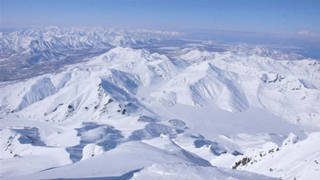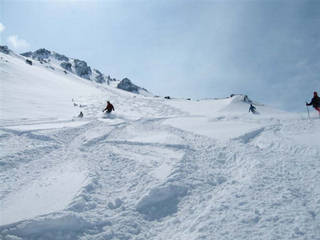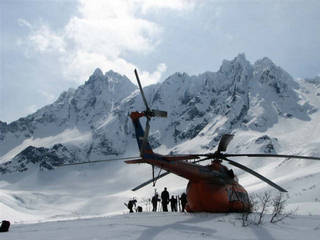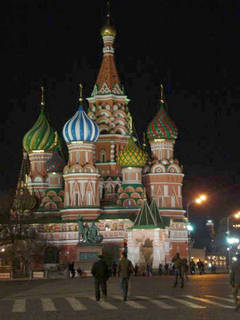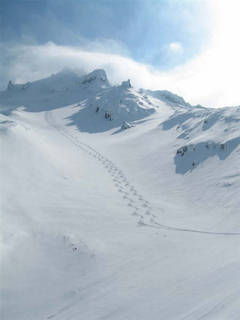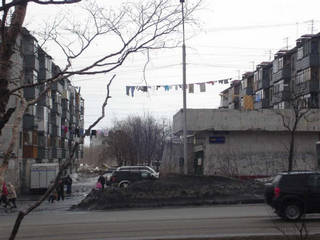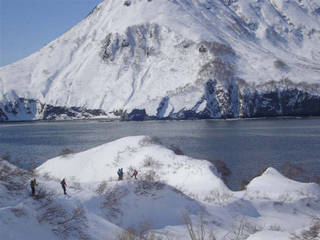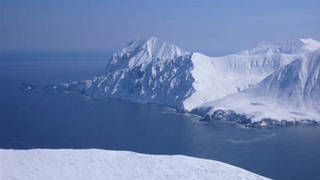Petropavlovsk, Kamchatka, Russia – We are all deep in thought as the roar of the helicopter’s engines takes us back to reality. Moving towards the take-off area, our hearts start beating faster. Like a lazy bumble bee the helicopter lifts off the ground and rises slowly. For a few seconds it seems to stand still in mid-air, then swings seemingly meaninglessly from left to right, before eventually deciding upon a direction in which it will take us. Happy to start a new adventure exploring the wilderness of the country ahead of us. And we are right in the middle of it.
|
The Kamchatka Peninsula, in the Russian Far East – the country of endless scenery. The view from atop the Avachinsky volcano. |
After the journey – which would make a good story in itself – we made it here. We are in the Russian Far East on the Kamchatka Peninsula, the country of endless scenery, with the Bering Sea to our east and the Sea of Okhotsk to our west. We cannot believe our eyes; right in front of us lie forests of birch trees, volcanoes, creeks and never-ending mountain ridges, none of which have been spoiled by human influence.
Our Russian 18-seat MI8 twin turbine helicopter is pretty loud and gets shaken quite a bit, but the beauty of nature below us lets any feeling of nervousness fade away. Twenty minutes in the chopper go by no time and we are nearing our first peak. Unfortunately, it is a bit windy, which makes it quite difficult for pilot Sergey to land. However after a few attempts he finds the right spot. The engines are roaring, the helicopter is hovering in mid-air, and all of sudden we can make out the first features. Rock formations maybe, but the downdraft whips snow and ice crystals through the air, making it hard for us to see what is underneath. Ivan, the engineer comes out of the cockpit to open the door of the chopper. He peers out as far as he can to be able to help his fellow pilots with the landing. With a sudden thud one wheel digs into the snow – it looks like we have landed even though the back wheels are still hovering above the white abyss. We are still trying to collect our thoughts/impressions while Andrej, our Russian guide, and Andy, our Austrian guide from the Arlberg region, are already thrusting our skis out of the door.
|
There is a white carpet rolled out front of us, a few kilometers long, made out of the lightest powder snow ever. Skiing in the region of Zhupanovsky volcano. |
Before we know it we are jumping four feet out of the heli with Andrej’s help, scrambling along a ledge and huddling close to the chopper, almost on top of each other. We had discussed all procedures at previous safety meetings, but in the heat of our first drop we almost forget to hold onto our poles. The door shuts, the roar of the motor intensifies, and for a short period of time as snow and ice crystals bring tears to our eyes we get to watch the helicopter lifting off above our heads, before we are forced by the sting to turn away. With a final shudder the helicopter is out of sight, swallowed by the endless valleys below.
Not far from the top of a 2700m (8,858-foot) mountain at the end of the world we are left to our own devices. The views are breathtaking. In the distance we can just make out the sea, and in between lie endless mountain ridges amongst which volcanoes stand out distinctively. Some of them still puff clouds of smoke. Birch forests cover the lower flanks of the volcanoes like carpets.
Slowly we start moving around, peering over one edge and then the other, making sure we do not miss out on anything. To be dropped together with 15 other people on top of a volcano, which we then get to ski down in untouched powder, exceeds all our expectations. At the bottom the bumble bee waits patiently ready to fly us back to the top.
We enjoy looking into the depth of the country, realizing that there is not a single soul around but us, that no phone will ring, and no music will be played, apart from the maelstrom in our heads fighting to describe the overwhelming emotions that we are all feeling. There is a white carpet rolled out front of us, a few kilometers long, made out of the lightest powder snow ever. So far no one has carved even one track into it.
|
Back at the helicopter in the Aag region. |
After a few minutes of silence everyone starts to get busy. The adrenalin level rises as we quickly click into our skis, very excited about our first run down. Am I strong and fit enough for this adventure? But there is no time to waste on thoughts like these; our guides are already waiting for us to finally put our first turns into this endless powder field. Da vai, da vai!
Andy jumps in first, and after a quick inspection finds conditions very safe. Nothing can hold us back now, and like a horde of wild animals we chase each other down the mountain. The first turns feel a bit stiff; however, as soon as we get a bit of a feeling for the snow underneath our feet an overwhelming lightness takes over. Every turn feels better than the last. We are caught in a state of trance as we are “dancing” down the volcano. The blur only returns to reality as we ski the runout to the helicopter. We manage to ski down the whole mountain with hardly a stop, no track touching the other. Each of us has left our own story carved into the white carpet. We are all looking back in awe as somebody shouts out, “One more, one more!” and we all join in…
Adventure begins in Moscow
Our travels to Kamchatka had already been an adventure. We arrived in Moscow late in the afternoon and decided to hit the city, especially to visit the famous Red Square and its surroundings. Our receptionist, a lovely lady who seemed to have already had a few drinks with the newlyweds celebrating at our hotel, gave us simple directions: taxi to the metro station, which would lead directly into the heart of the city. Andy – already experienced travelling in Russia – just held out his arm at the nearest street corner and, we could not believe our eyes, a very old rusty Lada stopped. After bargaining for the fare four of us squeezed into the tiny car and off we went.
|
Moscow’s Red Square at night is a sight to behold. St. Basil’s Cathedral. |
Taking tight corners at impossible speeds, the car squeaked and rattled. Dance music was spilling out loudly from the five speakers inside the little car and the sports’ steering wheel was barely attached to its rusty cousin. We still made it safely to the Red Square, which was flooded by warm light as the sun was setting. Moscow by night was definitely worth a look.
By the next morning we were onto the second stage of our journey. At the domestic airport we passed far more security checks than we were used to; it felt like we were going to meet Vladimir Putin himself. Once inside the smoke-filled waiting hall the tables were quickly covered by bottles of brandy that were consumed with haste. As soon as we were on the plane we understood why, since our flight attendant announced through the intercom, “You are not allowed to consume any drinks brought onboard apart from water.” Needless to say that the in-flight bar was sold out of alcohol in no time and once again bottles of brandy materialized out of nowhere. We were all partying in the aisles of our spacious Ilyushin 96-300, deep in conversation with our new-found Russian friends. Who needs in-flight entertainment when you are flying with Russians?
Nine hours later, flying across nine time zones and 120 degrees of longitude (the longest non-stop commercial flight within one country) we landed in Petropavlovsk-Kamchatsky. We were all a bit tired and weary, due also to the eleven hours of time difference. We stepped out of the plane to be greeted by a clear blue day with a friendly sun shining. Our hosts Nikolay and Vitaly welcomed us warmly. Their company, Vertikalny Mir, has been offering heliskiing trips in the Kaukasus and Kamchatka for more than 10 years, being the first ever to explore the Kamchatka region.
Our attention was immediately occupied by the three volcanoes (Koryaksky 3456m, Avachinsky 2741m, and Kozelsky 2189m) that stand out like guards behind the city, the former two still active. All together there are 300 volcanoes in Kamchatka, 29 of which are still active. Mutnovsky only last blew its top in 2001; nowadays we are back skiing on it.
Most people remember Kamchatka by playing “Risk”, the strategic board game of world conquest in which the peninsula is of strategic importance if you were going to invade North America. This is not far from the truth. Kamchatka has been a closed military zone and was a missile testing area during the Cold War. These days, people mainly live off salmon fishing, a bit of tourism and iron ore mining. In an area as big as Germany, Austria, and Switzerland together live about 378,000 people, 270,000 alone in Petropavlovsk. Twenty-seven percent of the peninsula has been declared National Park area, which hosts 134 rare species of fauna and flora. Petropavlovsk-Kamchatsky lies on the shores of Avacha Bay, a natural harbor in which Vitus Bering found shelter in the year 1740 on one of his scientific voyages. He laid the foundation of Petropavlovsk, named for his two ships, the sailing vessels “St. Peter” and “St. Paul”.
Whiteout
|
No need to farm lines on the northwest face of the Zhupanovsky volcano. |
The chopper has taken us back to the top. We have calmed down a little bit, perhaps because our body clocks are confused as we would be night skiing in our home time zone, even though it is bright daylight outside here on the peninsula. But before we know it the chopped door opens again and there is no time to dwell on thoughts of jetlag or exhaustion. This time we all know the drill, and soon we are huddled together watching the chopper disappear like a dragonfly behind some rock formations. We are back on the Avachinsky volcano. Is it dejá-vù or reality? Did we not just fly down this untracked snowfield? But there are no tracks to be seen. Andrej just laughs at us. “It is the same mountain, but it has got many different faces,” he explains. This time we have 1,700 vertical meters (5,577 feet) ahead of us.
Blinded by the excitement of completing one powder run after another we almost forget that we are hungry and our bodies are craving sustenance. With more than 7,000 vertical meters (23,000 feet) in our pockets we finally stop for lunch – after all, it is already 3:30 p.m. We descend upon the picnic like wolves from the forest, dining on delicious salmon, salami, and cheese sandwiches and some homemade cookies to give us a boost. While Andrej slurps on his black tea, he explains why we are skiing so hard today. “The weather is quite unpredictable here. On a perfect day like this we have to use every minute,” he says. “Normally, over nine days we average five days heliskiing.”
Andrej does not have to tell us twice. Everything is wrapped up and packed away quickly and off we go. On this first day we manage more than 11,000 vertical meters (36,000 feet), only to land next to a little creek at 7 p.m., tired but very happy. Andrej points to a little wooden hut, which functions as a changing room, and a natural pool fed by hot springs. Three minutes later we sit in the warm water, laughing and sipping champagne as we reminisce about the day’s events. The sun is still high in the sky, as darkness will not arrive in this part of the world before before 10 p.m.
The next morning as we pull back the curtains we realize how right Andrej had been about the weather. The complete whiteout cannot dull our spirits, though, for after all it means that our tracks will again fill in and we will ski more fresh powder.
|
Petropavlovsk is at first a bit depressing, with black volcanic dust covering the whole town. |
We decide to explore Petropavlovsk. Although our first impression is quite depressing, as we get to know people and buildings a bit better it grows on us. We get to watch sea lions playing in the ice cold water, visit the historical and cultural museum, and check out the new generation of freestylers whose parents cart them up the local hill via a very bumpy so that the kids are able to ride back down to sea level via one of the challenging kickers that stand out like monuments on the steep side of the hill.
In the afternoon we decide to try out dog sledding. There’s only one thing to mention: it is easier said than done. In the end we all fell off and rolled around in the snow. Moreover, we discover in the thick of the tundra some fairly fresh big bear prints. Kamchatka is home to more than 10,000 brown bears that unfortunately have recently attracted a few too many trophy hunters. At the end of winter the bears awaken from their long hibernation in the search of food. As we find out more and more about Kamchatka bears, the desire to see one face to face becomes irresistible. We were not to be disappointed…
“There’s a bear in my couloir!”
Max, one of our guides, got a closer look than he wanted the following day. Max had already skied ahead of us through one of the long gullies in the Bakening region. All of a sudden we heard a loud scream, “There’s a bear in my couloir!” He had almost skied into it. Luckily the bear is as frightened as Max, and tries to make itself scarce as quickly as possible, but not before we got to see it.
|
Some runs on the Veluchinsky volcano end right at the beach. |
Each of our remaining ski days are more exciting and adventurous than the other. In the South we ski on Veluchinsky volcano, which offers perfect corn snow and powder runs – take your pick. Some of them exceed 2,000 vertical meters (6,500 feet). In front of fjords and other volcanoes we get to ski all the way down to the beach, where some of our Russian friends cannot resist throwing themselves into the ice cold Pacific.
We pass mini-geysers, steaming blowholes, boiling hot sulphuric springs and fumaroles. We hold our hands close to the openings in the ground to test the temperature of the fumes. And we climb the crater of Mutnovsky volcano to look into clouds of sulphur rising from the depths of Mother Earth. We ski on glaciers past crevasses and ice formations, get to see a few more bears from a safe distance and drink wine and champagne while lounging in hot springs, some of which we even ski all the way down to.
Our fascination of this magical landscape, with its adventures and the warm hospitality of its inhabitants, has drawn us in such that in the end it is very hard to say goodbye. Kamchatka, we will be back!
The skinny:
Kamchatka offers heli-skiing from mid-March through mid-May.
Getting there:
Air travel via Moscow to Petropavlovsk-Kamchatsky aboard Aeroflot
|
Veluchinsky Bay |
Bookings:
VERTIKALNY MIR
Nikolay Veselovskiy
www.vertikalny-mir.com
neverstopski@yandex.ru
Andy Thurner/ Arlberg Guides
andyski@aon.at
www.outdoor-adventures.at
Tel: +43 664 2335010
Cost:
From about € 4000 (excluding flights), the package includes nine nights full board, 10 hours of helicopter flying time, all transfers, and skis, poles, and ABS backpacks (bring your own ski boots). Round-trip flights from London are available from about € 800.
Accommodation:
The Hotel Petropavlovsk, close to the center of town, is a 3-star facility with business center: www.petropavlovsk-hotel.ru

